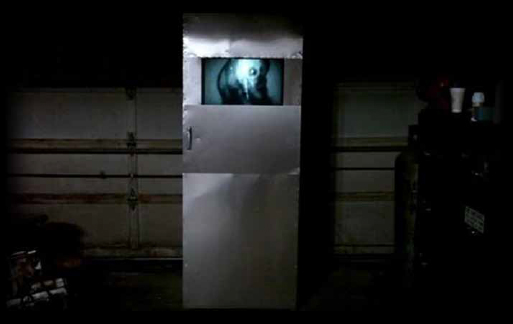 |
OCTOBER 2013
Design Hardware & Software
BY CABE ATWELL
|
Halloween is a time when kids and adults get the opportunity to step outside themselves and dress up in attire that would be deemed strange any other time of the year.
These attractions sure have come a long way from those back in the '80s when I was growing up. Back then, kids used their imaginations as we ventured through the local haunted houses, which were usually erected in a shopping plaza's parking lot. These were the kind that wwere built into several semi-trailers that were usually connected together to form several rooms.

The Raspberry Pi & air piston-based Scary Door.
Source: Cabe Atwell
The rooms were then outfitted with terrifying glow-in-the-dark ghosts, rubber serpents and spiders, and a host of teenagers made up to look like goblins that were going to drag us to their chamber of horrors.
The technology that made up those attractions is not in the same league as those found in cities across the U.S. in the 21st century. Most of the technology back then consisted of levers and pulleys that would move objects using fishing line. Sure, that’s not so scary, but factor in black lighting and strobe lights, and things seemed pretty frightening, especially being 12 to 14 years of age.
Fast-forward to today’s multi-million dollar haunts, and the difference in technology is night and day. The pulleys and fishing line have been replaced with pneumatic actuators that allow finely-detailed monsters to move. Gone are the simple black lights -- they’ve been replaced with IR (infrared) sensors and precision lasers that are able to detect movement and activate horrific props as patrons walk by.
All the technology these places feature (on a large scale) are controlled by a central hub or computer system, which controls everything from haunting sounds to incredibly realistic animatronic displays. For some of the bigger venues, fans are required to sign waivers as they proceed through the attraction, as well as required to wear an RFID bracelet that not only lets supervisors know your location, but are also used to trigger some of the displays themselves. Technology isn’t just centered on large attractions alone—home-brew haunted houses are taking advantage of it as well.
My Scary Door project is a prime example of how new technology is being implemented in at-home attractions. The door was designed using a 24-inch monitor that displays Halloween-themed videos embedded in a creepy sheet-metal laden door. Outfitted behind the door is a system of pistons and solenoid valves that strike the sheet metal in time with the video being displayed to create the simulation that someone (or something) is beating on the door. Trick-or-treaters engage the door’s scariness by triggering a Seco-Larm Enforcer break-beam device situated several yards before getting to the door itself. Controlling the show are two Raspberry Pi SBCs, with one for controlling the video output and the other, combined with a PiFace, for implementing the relays that fire the pistons. C and C++ code bind everything together for a technology-based haunted device that is capable of scaring the most reserved children looking to get their Halloween candy.
It’s easy to understand why scaring people is big business, as the revenue generated each year for these haunted attractions can easily be in the billions. This creates healthy competition for those who design such attractions to be the scariest in the nation. It’s most assured that as technology advances, so will our fears, which seem to grow as Halloween draws near and we venture through the “Scary Door”!
Happy Halloween!
|